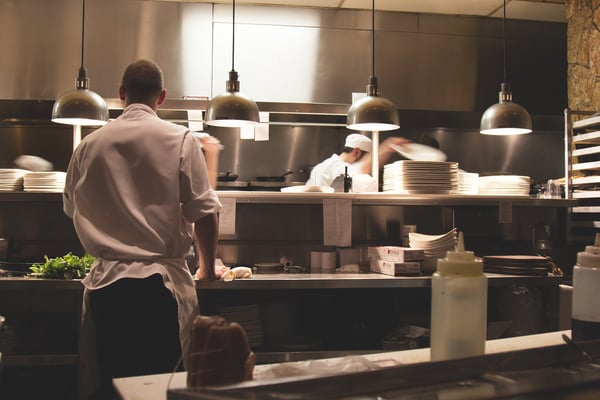Every year Earth Day is a time when everyone makes the extra effort to volunteer and be more environmentally friendly. Now its time to expand our efforts and make it apart of everyday operations in the restaurant industry. When getting started one of the major issues being tackled is how restaurants can reduce plastic in their operations. Here are a few simple things every restaurant can start doing today to reduce use of plastics and lighten their carbon footprint!
Ban Single-Use Plastics At Restaurants
Plastic is an incredible convenience to our daily lives. From our toothbrush to our credit cards to our computer: we pretty much can't get away from the stuff. We can, however, try to eliminate single-use plastics that are used only once before being thrown away or recycled.
Why Would We Do That?
I'm glad you asked. What happens to plastic materials before and after we use them takes a toll on our environment. Creating plastic is a process that involves a lot of oil and natural gas. In order to use these fossil fuels, we have to burn them and that introduces carbon dioxide into the air, which is a major cause of global warming. According to NASA, "Humans have increased atmospheric CO2 concentration by more than a third since the Industrial Revolution began." Finding reusable alternatives to single-use plastics not only slows global warming, but also reduces harm to our ecosystem. "Most plastics are not biodegradable and typically take more than 400 years to degrade" notes an article by Chelsea Ritschel for The Independent. Plastic breaks down into smaller bits that become easier for marine life to ingest, which can also end up in our restaurant's seafood supply.
Easy Solutions
Fortunately, single-use plastics are easily replaceable or even omitted.Cities across the world are making efforts to decrease the use of straws and here are a few ways you can too.
- Straws are one of the biggest offenders of plastic pollution. They're also an unnecessary expense. Either don't offer them or invest in alternative options like metal or biodegradable paper straws.
- A common practice is to only offer straws to customers that specifically ask for them
- If you're a coffee shop or a fast dining location, for cold drinks a fix is to change the style lid your order. Instead of a lid that requires a straw, using a lid that is similar to coffee or sippy cup lids.
- Water bottles have no place in a restaurant setting as they're easily replaced with glasses of water. For sparkling water, invest in a sparkling water tap built into your bar that will woo customers and always remain carbonated.
- Take-out containers come in many materials other than plastic. Opt for compostable containers made from plant material, like corn or sugarcane.
- Many restaurants place take-out containers in a plastic bag. Forgo the bag option for your patrons as one layer of container should do the trick.
Larger Orders with Less Delivery Days
Making small changes to your weekly ordering is a great way to be environmentally minded. Bulking up your orders to have less-frequent deliveries means less carbon emissions coming from the delivery truck on your behalf. It'll also help you lower the amount of delivery charges, so it's a win-win situation.
Ordering products in larger quantities is a great way to cut down on the amount of containers you'll be recycling after use. A full size keg of beer is the equivalent to 165 single-serve bottles of beer, but without all the packaging. Recycling is great, but reducing the amount of recyclables we use is even better.
Go Paperless
Menus are constantly evolving and needing revisions whether a new dish is on the menu or a fresh keg has been tapped. Updating your menu is a great way to build repeat customers, but can create a lot of paper waste. Digital menus, like Uncorkd, are a great way to make menu changes instantly without having to take the time to collect and replace all the menus in the restaurant. Aside from saving time, digital menus also allow you to save money on printing costs.
Green Cleaning
Green cleaning products offer many benefits, both to the environment and to ourselves. Not only are non-toxic cleaning products safer for your skin, they keep the air cleaner by not introducing harmful chemicals into your restaurant. Breathe easier knowing your staff and customers aren't occupying the same space as dangerous chemicals. Many eco-friendly cleaning supplies are also made using sustainable practices and packaged in biodegradable containers, lowering the impact of carbon emissions and pollution on our environment.
Local & House-Made
There's a reason sourcing locally is a trend: it supports your local economy, the product is fresher, it builds relationships within your community, and provides many environmental benefits. Being local means being nearby. Deliveries don't travel very far, which mitigates air pollution and gets you food while it's still fresh. Local food also comes in less packaging as smaller producers tend to put more time and energy into the product itself rather than the packaging.
Making house-made items rather than outsourcing is a great way to save money and reuse containers. Jams, vinegars, sausages, spreads, and sauces are quickly made in bulk. Customers will also be impressed with what's coming out of the kitchen.
Minimize Food Waste
One of the largest challenges that the restaurant industry faces is food waste. In the US alone more than 60 million tons of food is wasted every year. Not only is the food waste have a negative impact on our environment, but it cost the restaurant industry billions every single year.
There are a variety of different ways to decrease food waste in your restaurant and here is a list of a few:
- Portions: Serving large portions can result in customers wasting large amounts of food. It can be tricky to find the right portion sizes and keep customers happy, these Restaurant Portion Control Tools will help you find the best size for your dishes. Another option is to also offer multiple portion options to customers to avoid waste.
- Ordering: The key is to only order what you need. Fresh produce can go bad rather quickly so ordering items to avoid access will help you save money and also prevent food spoilage. A task for your waste management team is to keep track of which produce frequently spoils before it can be used. This will help you in adjusting your food orders.
- Imperfect Produce: In some restaurants it's a common practice to rid of foods with blemishes or otherwise visually imperfect. However making an effort to include these food items into your menu or using the bruised food items in other recipes. For instance Chef Rob Weland uses bruised ingredients in his cocktail mixes and other food sauces.
- Donating: There are a variety of different softwares that restaurants can use to find local charities that they can donate excess food too. Not only are you preventing waste you also contributing in the efforts to combat hunger. Below are links to a few different resources.
- Donation Apps
- Food Donation Connection provides useful information on food safety. FDC assists food service companies with putting their surplus food to good use.
- Sustainable America, A live interactive map that shows various food rescue non-profits in your are that can take your donations.
- ReFED is a donation matching software that forges the relationships between restaurants and nonprofits.





